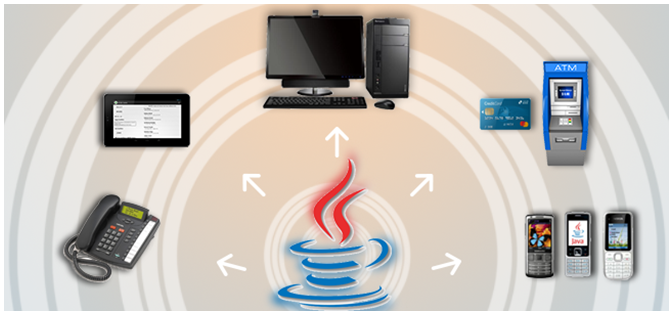The "Java" family of technologies has always been considered on the apex of all software technologies. Owing to its salient features, such as flexibility, open source nature, compatibility, ease of use, adaptability and many more, Java has always been interweaving itself into multiple latest happenings, frameworks and architectures. Java Application Development has been pervasive in the embedded space at a very rapid rate. Java has been chosen as the apt language for embedded devices owing to the continuously increasing complexities in the software arena.
This embedded technology is woven into devices and systems, ranging from chips (on credit cards or ID cards) to bigger server class instruments to home driven equipments and is tightly coupled with the device. It brings about a real time experience for the user. Today, there are many daily usage devices based on this technology and Java is spreading its embedded wings into devices like SIM cards, printers, bank machinery, mobile handsets, TV, AC to name a few.
Java Embedded is usually not available for direct download or installation to users. It is based on an integration mechanism by the electrical / electronic manufacturers, directly on the device.
Why is Java Embedded getting so popular and in-demand?
• Since it is highly functional, trustworthy, convenient and secure, Java Embedded tends to get attracted to solution providers at a breath taking pace.
• It is bound to improve product quality.
• Presence of standardized class libraries is bound to increase productivity and decrease rework.
• It can encompass small as well as large embedded appliances.
• One of the major highlights is its portability because of its OS independent nature. Hence, code written once can easily be ported on to any type of hardware.
• Ensures good quality and higher performance.
• Bound to reduce the Total cost of ownership and thereby fasten processes.
• Higher level of code modularity and OOPS concepts lead to development of a robust and scalable software application.
How is Internet of Things (IoT) Imbibing Java Embedded?
Internet of Things (IoT) is a concept creating waves today, in the industry, encompassing not only companies but homes too. It can be explained as a network consisting of material units which are connected via various wireless mechanisms. Their units have inbuilt sensors and embedded technologies and this is what they use to sense and communicate. Owing to IoT, daily utility things are connected the Internet and are being stuffed with intelligence. It is wondrous to see how these devices are able to talk to each other digitally and centrally, ensuring higher efficiency in quality, security and cost savings.
SPEC INDIA, an ISO 9001:2008 software development company, has its proficiency proven in Java Application Development with numerous projects and applications successfully implemented world-wide, for a wide range of clientele. Its experience in creating n-tier applications with MVC technologies giving Java / J2EE development services, has been remarkable. Java Embedded is an area in which SPEC has proven its presence.
This embedded technology is woven into devices and systems, ranging from chips (on credit cards or ID cards) to bigger server class instruments to home driven equipments and is tightly coupled with the device. It brings about a real time experience for the user. Today, there are many daily usage devices based on this technology and Java is spreading its embedded wings into devices like SIM cards, printers, bank machinery, mobile handsets, TV, AC to name a few.
Java Embedded is usually not available for direct download or installation to users. It is based on an integration mechanism by the electrical / electronic manufacturers, directly on the device.
Why is Java Embedded getting so popular and in-demand?
• Since it is highly functional, trustworthy, convenient and secure, Java Embedded tends to get attracted to solution providers at a breath taking pace.
• It is bound to improve product quality.
• Presence of standardized class libraries is bound to increase productivity and decrease rework.
• It can encompass small as well as large embedded appliances.
• One of the major highlights is its portability because of its OS independent nature. Hence, code written once can easily be ported on to any type of hardware.
• Ensures good quality and higher performance.
• Bound to reduce the Total cost of ownership and thereby fasten processes.
• Higher level of code modularity and OOPS concepts lead to development of a robust and scalable software application.
How is Internet of Things (IoT) Imbibing Java Embedded?
Internet of Things (IoT) is a concept creating waves today, in the industry, encompassing not only companies but homes too. It can be explained as a network consisting of material units which are connected via various wireless mechanisms. Their units have inbuilt sensors and embedded technologies and this is what they use to sense and communicate. Owing to IoT, daily utility things are connected the Internet and are being stuffed with intelligence. It is wondrous to see how these devices are able to talk to each other digitally and centrally, ensuring higher efficiency in quality, security and cost savings.
SPEC INDIA, an ISO 9001:2008 software development company, has its proficiency proven in Java Application Development with numerous projects and applications successfully implemented world-wide, for a wide range of clientele. Its experience in creating n-tier applications with MVC technologies giving Java / J2EE development services, has been remarkable. Java Embedded is an area in which SPEC has proven its presence.




Post a Comment